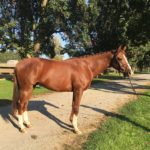I mentioned that it’s best to think of the Tevis Cup as three 30+ mile races.

You have race #1 – leaving Robie Park (close to Truckee, CA – 7,000 feet above sea level) at 5:15 AM with upwards of 200 horses (I’d call it a “controlled mass start”) you descends gradually to cross the Truckee River on Highway 89. Then riding through the Squaw Valley ski resort, you head up to Emigrant Pass (8,750 feet). Old mining trails lead you through the Granite Chief Wilderness, famous for its black boggy spots which hide rocks from unwary hooves. A few quick vet checks and a hair-raising trip over Cougar Rock [see pic of me going over on Tosca in 2004] later you arrive at Robinson Flat for an hour hold and thorough veterinary exam.
At Robinson most horses are still pretty amped up and the main goal after you vet through is to get them to relax so they can eat and drink for as much of the hour hold as possible. Saddles and bridles come off, splint boots are removed and cleaned, feet are checked and – depending on the ambient temperature – water is put on the horse to cool it down as quickly as possible.
Front runners arrive at Robinson – 36 miles in – around 9:00 AM (about a four hour trip and an average speed of 9 mph – fast for the terrain) and it’s a ghost town by noon.
I should illuminate at this point that it takes a village to get each horse and rider team through Tevis. It’s ideal to have at least three crew members at both of the major vet checks (they can double up, but it’s a long day for them) and someone assigned to stay up and keep an eye on the horse throughout the night after you finish. These people start carrying buckets and making sandwiches at the crack of dawn and often will stay up until their rider finishes in the wee hours of the next morning. Crew are amazing.







